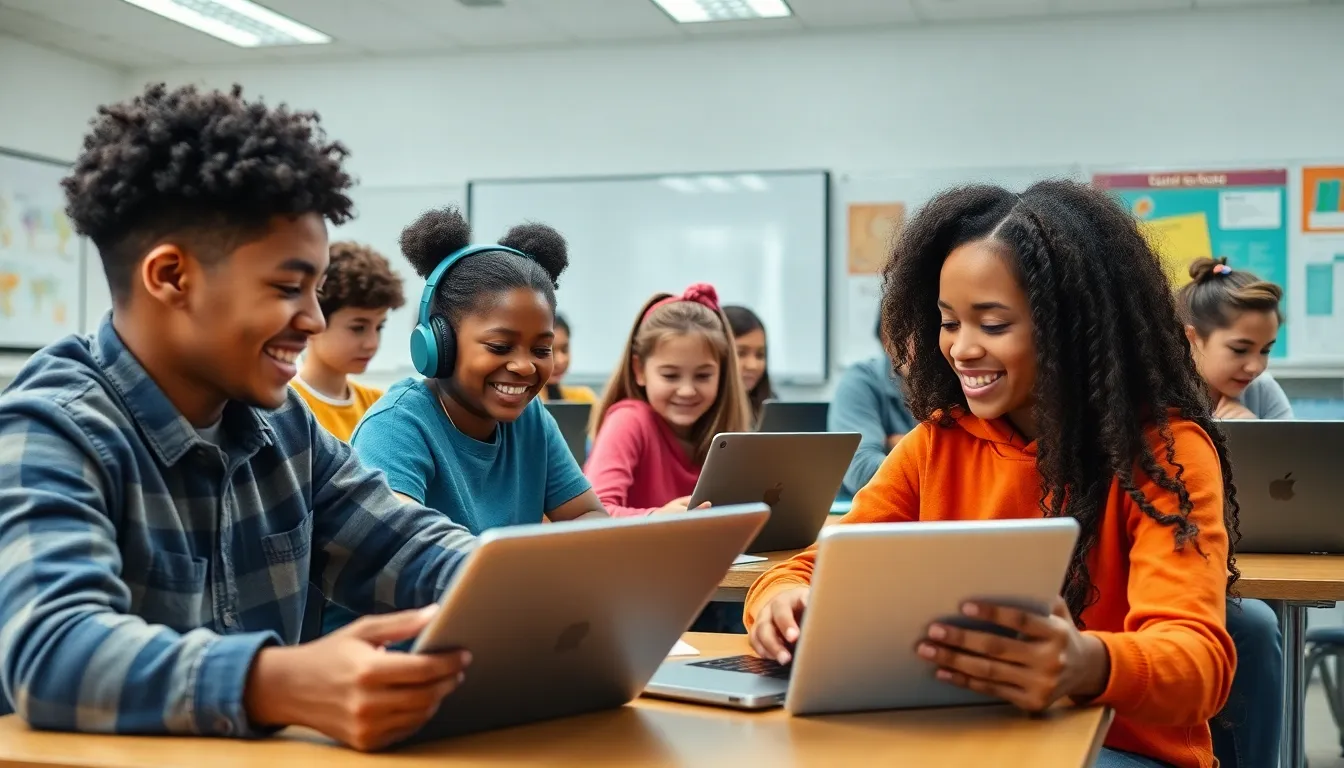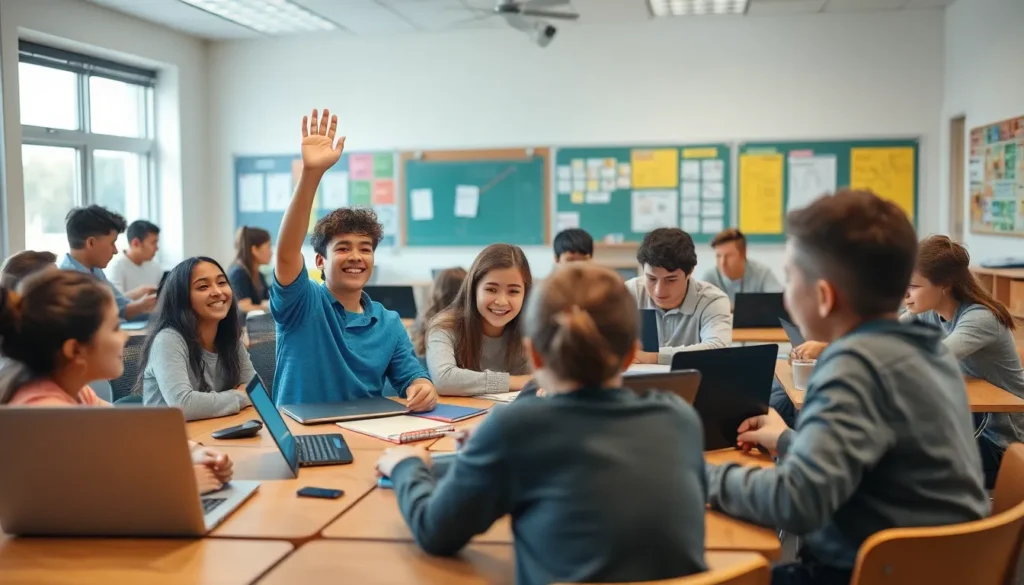In a world where smartphones are practically glued to our hands and Wi-Fi is more essential than coffee, it’s no surprise that technology has made its way into the classroom. Gone are the days of dusty chalkboards and endless rows of textbooks. Today, students are tapping into a universe of knowledge with just a swipe of their fingers.
Imagine a classroom where learning feels more like a video game than a chore. With innovative tools and online resources, education is transforming into an engaging experience that captures students’ attention. From interactive apps to virtual classrooms, technology is not just a trend; it’s the future of education. So buckle up as we dive into how these advancements are reshaping learning and making it more accessible than ever.
Table of Contents
ToggleOverview of Technology in Education
Technology significantly enhances education by providing diverse tools and resources. Online platforms, learning management systems, and educational apps facilitate personalized learning experiences. Classroom environments transform, encouraging collaboration among students through digital platforms.
Students access information instantly through smartphones and tablets, creating a more interactive atmosphere. Educators utilize multimedia resources and virtual reality to engage learners, making complex subjects understandable. Data analytics in education allows teachers to track progress and adapt strategies effectively.
Innovative tools help simplify administrative tasks. Automation in grading frees educators to focus on instruction and student interaction. Cloud computing enables resource sharing among teachers, promoting community and collaboration.
Students benefit from adaptive learning technologies that respond to their individual needs. Many institutions now incorporate gamification, turning lessons into immersive activities that capture students’ interest. Online courses and MOOCs broaden access to quality education, reaching learners in remote areas.
As technology continuously evolves, its integration becomes crucial for modern education. Embracing these advancements fosters a culture of lifelong learning. Not only does this shift prepare students for future careers, but it also equips them with essential skills for navigating a digital world.
Benefits of Technology in Education

Technology in education offers numerous advantages that transform learning environments and student experiences.
Enhanced Learning Experience
Innovative tools create interactive lessons that engage students more effectively. Multimedia resources, such as videos and simulations, simplify complex concepts and cater to various learning styles. Educators frequently utilize virtual reality to immerse students in subjects like history and science, providing a first-hand view that traditional methods can’t offer. Gamification elements make learning enjoyable, fostering a sense of competition and achievement among learners. Personalized learning experiences arise from adaptive technologies, allowing educators to tailor curricula according to individual student needs. Tracking student progress through data analytics strengthens interventions and supports targeted instruction.
Increased Accessibility
Increased access to educational resources stands as a primary benefit of technology in education. Online platforms deliver quality content to learners regardless of geographic location. For instance, students in remote areas can participate in courses through MOOCs and online programs, breaking down barriers to traditional education. Cloud-based tools enable seamless collaboration, allowing students to work together on projects regardless of physical presence. Accessibility features, such as screen readers and translation tools, ensure that diverse learners can engage fully with materials. Furthermore, educational apps reach students on smartphones, providing learning opportunities anytime and anywhere.
Challenges of Technology in Education
Technology in education faces several challenges that can hinder its effectiveness. These obstacles can impact both students and educators.
Digital Divide
The digital divide remains a significant concern. Students from low-income families often lack access to essential devices and high-speed internet connections. This disparity limits their ability to engage with online learning resources fully. Educational institutions must prioritize ensuring that all students have the necessary tools and connectivity. In 2020, about 17% of students in the United States did not have access to broadband at home. Addressing this issue requires comprehensive strategies to bridge the gap between different socio-economic groups.
Teacher Training and Support
Teacher training and support significantly influence technology integration in classrooms. Many educators feel unprepared to utilize new technologies effectively. Professional development programs require enhancement to meet the needs of instructors. In fact, a survey revealed that 58% of teachers were not confident in their technology skills. Schools must provide ongoing training and resources that equip teachers with the knowledge to implement technology successfully. Encouraging a culture of support fosters collaboration among teachers and ultimately improves student learning outcomes.
Innovative Tools and Platforms
The integration of innovative tools and platforms significantly enhances the educational experience. These advancements transform traditional learning environments into engaging spaces.
Learning Management Systems
Learning management systems (LMS) streamline educational processes. They provide centralized platforms for organizing course content, tracking student performance, and facilitating communication. With features like grading automation and assignment submissions, LMS supports educators in managing their classrooms more efficiently. Institutions can choose from popular platforms like Canvas and Moodle to tailor the system to their unique needs. As a result, students access resources and interact seamlessly with instructors and peers, fostering collaboration and improving learning outcomes.
Interactive Learning Applications
Interactive learning applications engage students through immersive experiences. These applications promote active participation, making learning enjoyable. Apps such as Kahoot and Quizlet allow learners to take part in quizzes and flashcards that cater to various subjects. Visual elements and gamified components heighten motivation and stimulate interest in challenging topics. Personalized learning through adaptive technology enables students to progress at their pace, addressing individual learning styles effectively. Consequently, these applications not only enhance knowledge retention but also encourage a love for lifelong learning.
Future Trends in Technology in Education
Emerging technologies are poised to significantly shape the future of education, fostering innovative and engaging learning experiences for all students.
Artificial Intelligence in Classrooms
AI tools personalize education by adapting to individual student needs. These systems analyze learner data to create customized learning paths, ensuring that each student’s strengths and weaknesses are addressed. Furthermore, AI chatbots provide instant feedback, facilitating supportive environments for students. Educators benefit as well, receiving insights into student performance, enabling them to make informed instructional decisions. The integration of AI in classrooms transforms traditional teaching methods, enhancing both efficiency and effectiveness.
Virtual and Augmented Reality
VR and AR technologies immerse students in engaging, interactive learning experiences. Such tools allow learners to explore complex subjects, like history or science, through simulated environments. Virtual field trips enable exploration of distant landmarks, while augmented reality overlays digital information on physical objects. Educators leverage these technologies to capture student interest, improving knowledge retention through experiential learning. Overall, VR and AR enhance instruction by making education more visual and accessible.
Technology’s role in education is transformative and continues to evolve. By integrating innovative tools and platforms, classrooms are becoming more engaging and accessible. This shift not only enhances the learning experience but also prepares students for a future driven by digital advancements.
As educational institutions navigate the challenges of technology, prioritizing access and teacher training is essential. Embracing emerging technologies like AI and VR can further enrich the learning environment, making it more interactive and personalized.
Ultimately, the journey toward a tech-driven educational landscape is just beginning, and its potential to revolutionize learning is immense.





